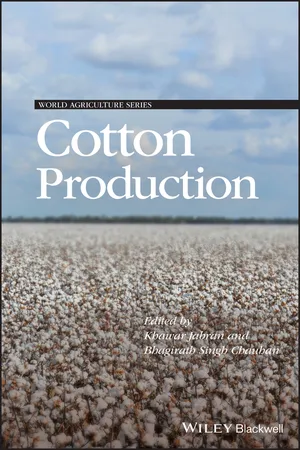
Cotton Production
- English
- ePUB (mobile friendly)
- Available on iOS & Android
Cotton Production
About This Book
Provides a comprehensive overview of the role of cotton in the economy and cotton production around the world
This book offers a complete look at the world's largest fiber crop: cotton. It examines its effect on the global economy—its uses and products, harvesting and processing, as well as the major challenges and their solutions, recent trends, and modern technologies involved in worldwide production of cotton.
Cotton Production presents recent developments achieved by major cotton producing regions around the world, including China, India, USA, Pakistan, Turkey and Europe, South America, Central Asia, and Australia. In addition to origin and history, it discusses the recent advances in management practices, as well as the agronomic challenges and the solutions in the major cotton producing areas of the world. Keeping a focus on global context, the book provides sufficient details regarding the management of cotton crops. These details are not limited to the choice of cultivar, soil management, fertilizer and water management, pest control, cotton harvesting, and processing.
- The first book to cover all aspects of cotton production in a global context
- Details the role of cotton in the economy, the uses and products of cotton, and its harvesting and processing
- Discusses the current state of cotton management practices and issues within and around the world's cotton producing areas
- Provides insight into the ways to improve cotton productivity in order to keep pace with the growing needs of an increasing population
Cotton Production is an essential book for students taking courses in agronomy and cropping systems as well as a reference for agricultural advisors, extension specialists, and professionals throughout the industry.
Frequently asked questions
Information
Chapter 1
An Introduction to Global Production Trends and Uses, History and Evolution, and Genetic and Biotechnological Improvements in Cotton
1.1 INTRODUCTION
Table of contents
- Cover
- Table of Contents
- List of Contributors
- Chapter 1: An Introduction to Global Production Trends and Uses, History and Evolution, and Genetic and Biotechnological Improvements in Cotton
- Chapter 2: Morphology, Physiology and Ecology of Cotton
- Chapter 3: Water Management in Cotton
- Chapter 4: Nutrient Management in Cotton
- Chapter 5: Insect Pest Management in Cotton
- Chapter 6: Weed Management in Cotton
- Chapter 7: Integrated Management of Major Fungal, Bacterial, Viral, and Nematode Diseases of Cotton
- Chapter 8: Seed Production, Harvesting, and Ginning of Cotton
- Chapter 9: Cotton Production in China
- Chapter 10: Cotton Production in India
- Chapter 11: Cotton Production in the United States of America
- Chapter 12: Cotton Production in Pakistan
- Chapter 13: Cotton Production in Brazil and Other South American Countries
- Chapter 14: Cotton Production in Turkey and Europe
- Chapter 15: Cotton Production in Central Asia
- Chapter 16: Cotton Production in Australia
- Chapter 17: Cotton Production in Africa
- Chapter 18: Challenges and Opportunities in Cotton Production
- Index
- End User License Agreement